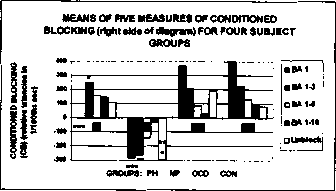376
R. D. Oades et al.
twice as long on sessions A and B as the others, with the PH needing more time than the
NP group (Figure 2, right).
Correlations between these “learning measures” for each group provide an indication of
the differences of task-solving strategy used. Most correlations were highly specific to the
phase of learning for each subject group (e.g. trials and exploration time on A, r= + .77-
.92,∕><.0001; trials on B phase ii and duration r= + .69-.84, p=.Ol--OOOl). Measures on
sessions A and B did not correlate with two exceptions: for PH alone, A and B test
exploration times correlated (r= + .80,/? = .001) and for NP alone the number of learning
trials on the two three-stimuli phases correlated (r= + .78, p= .003: see Discussion).
Examination of the contribution of psychopathology to slower learning in psychotic
patients showed no correlation with negative or positive symptom ratings. Brief psychiatric
ratings for positive, negative or psychotic symptoms and HANES personality ratings were
not related to any learning measure. However, a clear relationship was found between an
increased number of trials on the three-stimuli phase of session B and MMPI scores for
neuroticism (3 Ns), psychopathy (4-9) and schizotypy (2-7-8, 8-9: « = 33, r= +.59-.67,
∕><.0001; significant with а-correction). There were similar correlations with exploration
and duration in the final learn and test phases.
Conditioned blocking (CB)
A CB effect for controls and OCD patients of about 4 s on the first trial pair decreased
across the test session with learning about the added stimulus (Figure 3). AMANOVA was
performed with repeated measures to see which of five related measures of CB might show
group differences [F(8,260)=2.51, p = .012]. The covariate of IQ proved to have a trivial
effect on these measures Щ8,256) = 2.37;p= .018]. Normal CB levels on each measure were
reduced in the psychotic patients, but only significantly so for the first trial-pair comparison
(p<.0001). CB across trials 1-3 and 1-5 (the best CB measures in healthy subjects; Oades

Figure 3. Normal CB scores are positive: for the comparison groups, on the right, CB decreased successively
across test trials. On the left, PH and NP groups showed attenuated CB on the first trial (***.0001 <p<.01) (PH
vs CON, NP vs OCD or CON). NP continued to show reduced CB across trials (**.0l <p < .05 vs CON). But PH
showed normal CB from the three trial measure onwards (*p<Λ vs NP on BA 1-3 and unblocking).
More intriguing information
1. The name is absent2. IMMIGRATION AND AGRICULTURAL LABOR POLICIES
3. Investment and Interest Rate Policy in the Open Economy
4. THE INTERNATIONAL OUTLOOK FOR U.S. TOBACCO
5. THE RISE OF RURAL-TO-RURAL LABOR MARKETS IN CHINA
6. The name is absent
7. Non-causality in Bivariate Binary Panel Data
8. Globalization, Divergence and Stagnation
9. Globalization, Redistribution, and the Composition of Public Education Expenditures
10. Better policy analysis with better data. Constructing a Social Accounting Matrix from the European System of National Accounts.